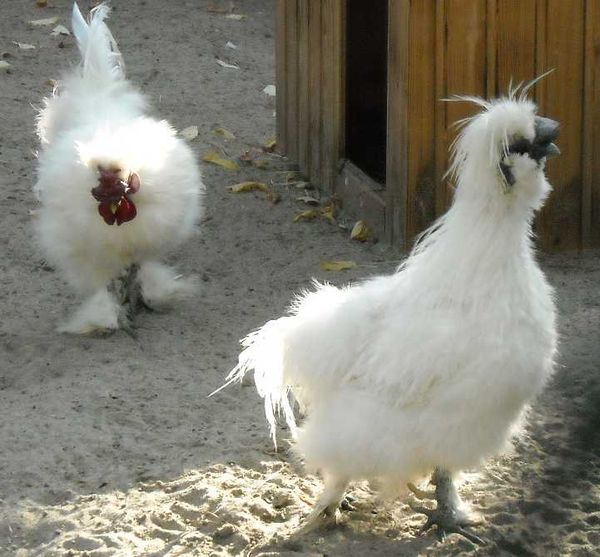Among all the traditional types of poultry, chicken is the most common inhabitant of the household. Moreover, quite a lot of species of this bird are distinguished, among which there are exotic ornamental breeds.
Namely, silk chickens of Oriental origin, which are not traditional layers, but really surprise with their attractive appearance and docile temperament.
Table of contents
- The origin of silk chickens- "Chinese"
- Appearance of birds
- The nature of the hens of this breed
- Care and maintenance rules: tips and videos
- Description of productive features
- Characteristics and differences of the rooster from the chicken
- Growing conditions
- Eating young
- Breeding characteristics
- Silk hen diseases
- Advantages of the Chinese breed
- Breed flaws
- Owner's reviews about the breed
The origin of silk chickens- "Chinese"
The birthplace of this bird is considered to be the Chinese state, where almost 1000 years ago, the first representatives of the breed. A little later, they spread to European areas, including Russia.
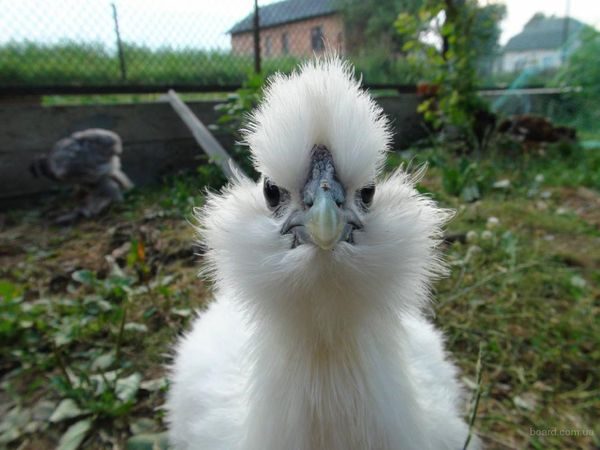 The first mentions of this bird appeared in the 16th century, but already then active disputes began about the exact origin of chickens and their class biology.
The first mentions of this bird appeared in the 16th century, but already then active disputes began about the exact origin of chickens and their class biology.
Interesting: some experts believe that silk chickens are a mix of chicken and rabbit.
Appearance of birds
This breed is classified as decorative and domestic. Silky inhabitants have a rounded torso, soft, pleasant feather cover, which resembles a silk fabric by touch.
Such a silky cover is due to the fact that there are no hook-like grooves on the feathers. Such hooks are located only on the tail section and on the tips of the wings.
Among other things, in the body of these birds in large quantities contains melanin, which stains the skeleton and the skin in a dark blue palette. Because of this peculiarity of the organism, the soft areas of the cover turned out to be a rich shade of turquoise, and the beak and comb are plain blue.
And some representatives of the breed are awarded with a so-called beard and sideburns. Such distinctive nuances of appearance made the hens look like poodles with "berets" on top. Below you can see photos of this breed.
 These birds have a compact and flat back. The legs are small and densely covered with plumage. The eyes are almost black. As for the color of feathers, they are almost always black. But there is a golden color, gray, red, white and blue. The weight of one such bird is about 1.5 kilograms.
These birds have a compact and flat back. The legs are small and densely covered with plumage. The eyes are almost black. As for the color of feathers, they are almost always black. But there is a golden color, gray, red, white and blue. The weight of one such bird is about 1.5 kilograms.
Another difference silk representatives - the number of toes on the paws. Ordinary chickens have four fingers each, and the exotic breed has five, and they are also covered with feathers.
The nature of the hens of this breed
These birds are surprisingly friendly and calm. And of all types of poultry, these representatives of the breed willingly go to people to contact.
Silk hens can often be found in contact zoos, and in the “homeland” in China they are kept as pets at all, as they allow themselves to be taken on their knees and love tender stroking. And most importantly, they are not capricious to the living conditions.
These birds have a well-developed instinct for incubation. They are friendly and affectionate. But the main disadvantage of the breed can be called a slight degree of productivity and expensive incubation "material" for cultivation.
Care and maintenance rules: tips and videos
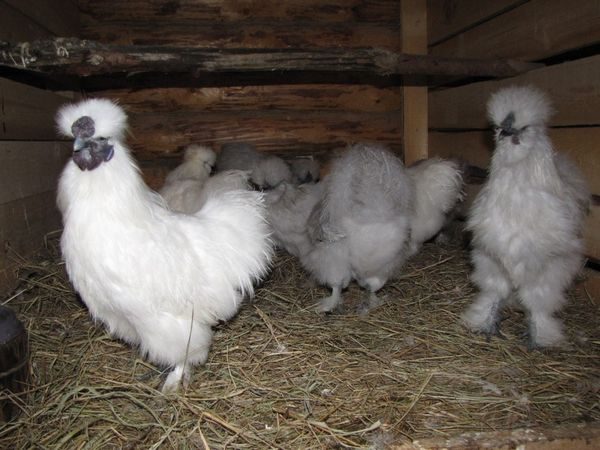 This cute variety of chickens does not imply any special content requirements. It is possible at home to get this exclusive pet, almost no different from the usual chicken.
This cute variety of chickens does not imply any special content requirements. It is possible at home to get this exclusive pet, almost no different from the usual chicken.
Standard care requirements:
- feeding is important to carry out timely and only high quality products;
- these birds are very demanding cleanliness and sanitary cell standards;
- the eastern silk variety is resistant to low temperatures, however, it is important to ensure the heat and lightso the chickens continue to lay eggs;
- for walking it is important to provide own pento protect the birds from predators.
The absence of walking silk chick does not hurt. The eastern hen lacks the ability to fly, so it is not at all necessary to equip the roosts in the cages. And do not forget that these birds require full solar conditions, that is, a sufficient amount of light in the house.
You can learn more about the content in this video:
Description of productive features
In China, the meat of silk chickens is highly valued, as it is surprisingly tasty and has dietary properties. 
The Chinese have long studied all the beneficial qualities of the meat of this bird, namely, its composition contains calcium, various amino acids, phosphorus, nicotinic acid and many vitamins.
Chinese birds are appreciated by Chinese for down and feathers. Total pairs of haircuts of one bird gives fluff, weighing up to 150 grams. On the whole, the domesticated bird of this breed is able to bring a lot of joy to its owner, it is interesting to watch her, especially for clumsy movement.
Characteristics and differences of the rooster from the chicken
This breed has several subspecies, differing in the color of their plumage: red, yellow, blue, black, and so on.
The weight of roosters reaches one and a half kilogram, and hens can weigh up to 1.1 kilograms. As for egg production, one individual is able to produce a hundred eggs each year, each weighing 35 grams. The shell is colored brown, and the eggs themselves have an enhanced nutritional complex.
Growing conditions
The chicks of the Chinese silky variety are sensitive to tangible temperature fluctuations, so care should be taken to educate them. The main rule for the young: it is a rich nutritional menu, a balanced mode and the provision of optimal temperature parameters in the chicken coop.
Incubator chickens
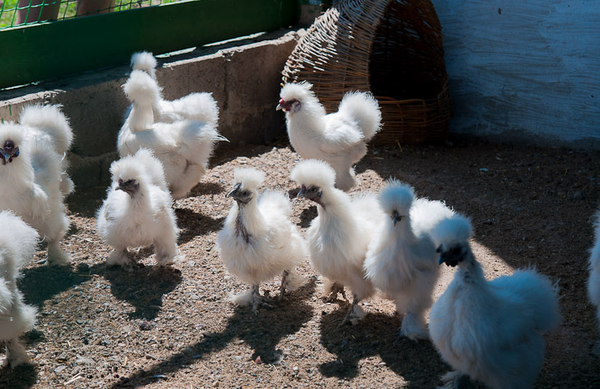 If you plan to grow a breed through an incubator, then consider the following points:
If you plan to grow a breed through an incubator, then consider the following points:
- chickens of these birds are much smaller in sizethan traditional hens, so they are sensitive to temperature changes;
- Immediately after hatching, the chicks should stay for a long time in the room where temperature should be +30 degrees;
- a week later, the figures are falling three degreesbut no more;
- monthly chicks develop well already at a temperature +18 degrees.
Eating young
In the daily menu of the future adult, it is important to include useful items like boiled yolk, low-fat cottage cheese or sour cream, boiled carrots, semolina or corn grits. Do not forget about the ready store vitamin complexes. Hatching chickens are fed every two hours.
As soon as the babies have reached the age of one month, they can be fed three times a day, while the grain is actively added to the diet.It is also recommended to feed young animals with clover, mint pumpkin, millet and other types of products. Water in the drinker should always be clean.
Breeding characteristics
The price of these decorative representatives of the family of birds is much higher compared to the cost of traditional chickens.
For example, one egg of silk “Chinese” will cost you five dollars, and you will have to pay about seven dollars for a chicken. The price of an adult chicken is about $ 50.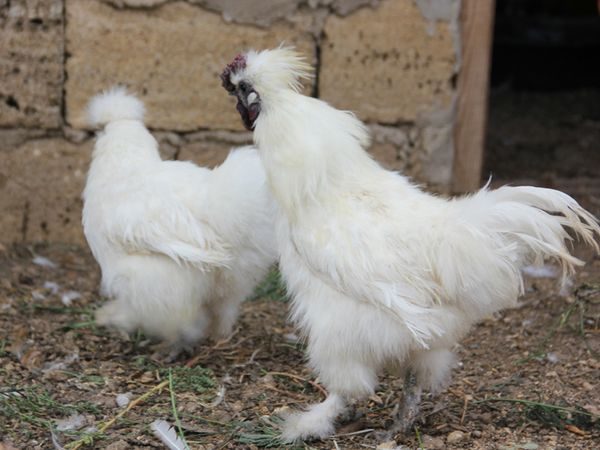
You can buy such an interesting breed only in specialized pet stores, on professional farms or on the official markets of agricultural land.
When buying silk chickens should help them as much as possible to adapt to the new territory. But the main way of growing is still hatching eggs by an adult bird.
Silk hen diseases
Oriental chickens, like the traditional rural bird, are also susceptible to many diseases. Chickens are often attacked by such parasitic insects as fleas, ticks, and fluff eaters.And because of not controlling the humidity indicators in the chicken coop, the youngsters quickly wither and in most cases die.
As for the diseases of adults, then the following ailments are common:
- poisoning organism;
- viruses pulmonary system;
- inflammatory processes in the digestive system;
- rickets;
- infectious intestinal viruses;
- appearance worms;
- coccidiosis.
Disease prevention
To avoid all of the above diseases, it is important to observe the following points.
- First of all, pens should always be clean, systematic cleaning is important.
- Secondly, nutrition should be fresh, with the mandatory addition of vitamins to the diet, which are the source of health.
- Thirdly, regularly change the water in a drinking bowl.
- Fourth, provide enough chickens by walking, and in severe frosts do not forget to warm the chicken coop.
Finally, as soon as you notice signs of weakness or illness, immediately isolate the sick individual from other birds. It is recommended to seek help from a veterinarian, and for the rest of the birds carry out prevention.
In fact, silk “Chinese”, with proper care, practically do not get sick, despite the harsh Russian climate.
Advantages of the Chinese breed
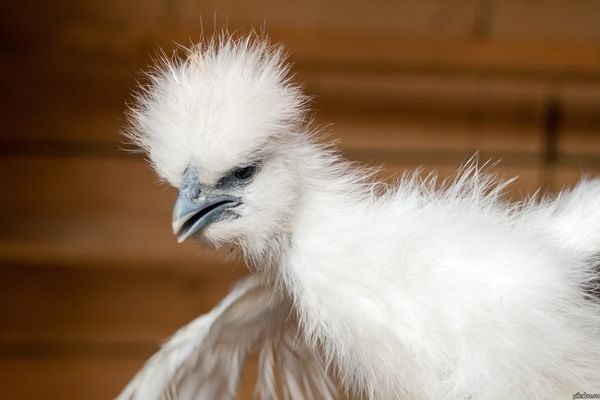 The hens in question are not only very attractive, but also highly valued in rural industry.
The hens in question are not only very attractive, but also highly valued in rural industry.
- Meat rooster and chicken tender and dietary, rich in vitamins.
- Silk downLike sheep's wool, it is used in rural industry.
- Eggs Silk "Chinese" are quite large, despite the size of the layers themselves.
- Chickens are calm, do not fly and happy contact with people.
- Silk hens not whimsical conditions of detention and quietly multiply in the Russian climate.
Breed flaws
The disadvantages include a low degree of productivity and the high cost of acquiring incubation “offspring” or chickens.
Owner's reviews about the breed
The main part of people is “bought” on the exterior of silk “Chinese” and on their friendly character. Practice shows that this breed is loved in our country not for the high value of meat or eggs, but for its attractiveness and amusement.
Despite such exoticness, these birds easily get used to the new owners, perfectly adapt to the harsh conditions of existence and are considered picky pets.
For the Russian area, a decorative type of silk “Chinese” is relevant, in the homeland itself (in China), such chickens are grown commercially. In Russia, people few are engaged in the cultivation of this breed.
Most likely, this is due to the decorative orientation of these chickens. As a rule, the number in the hen house does not exceed more than a dozen.
But all the reviews of the owners are very positive, since the meat of these birds and their eggs are suitable for consumption. The owners note that chickens are tidy, and even in the "dirty" seasons they manage to keep the fluffy plumage clean.
Watch the video describing the Chinese silk aborigines:
